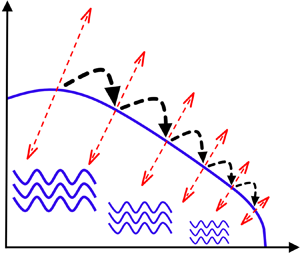No CrossRef data available.
Published online by Cambridge University Press: 25 November 2024

In this work we study features of inertia-gravity wave turbulence in the rotating shallow water equations. On examining the dynamics of waves with varying rotation rates, we find that the turbulent cascade of waves is strongest at low rotation rates, forming a  $k^{-2}$ energy spectrum, and a rich distribution of shocks in physical space. At high rotation rates, the forward cascade of waves weakens along with a steeper energy spectra and vanishing of shocks in physical space. The wave cascade is seen to be scale-local, resulting in a noticeable time interval for energy to get transferred from domain scale to dissipative scale. Furthermore, we find that the vortical flow has a non-negligible effect on the wave cascade, especially at high rotation rates. The vortical flow assists in the forward cascade of waves and shock formation at high rotation rates, while the waves by themselves in the absence of the vortical flow lack a forward cascade and shock formation at such high rotation rates. On investigating the physical space structures in the vortical flow and their connections to the wave cascade, we find that strain-dominant regions, that are located around the boundaries of coherent vortices, are the physical space regions that contribute majorly to the forward cascade of waves. Our results in general highlight intriguing features of dispersive inertia-gravity wave turbulence that are qualitatively similar to those seen in three-dimensional homogeneous isotropic turbulence and are beyond the predictions of asymptotic resonant wave interaction theory.
$k^{-2}$ energy spectrum, and a rich distribution of shocks in physical space. At high rotation rates, the forward cascade of waves weakens along with a steeper energy spectra and vanishing of shocks in physical space. The wave cascade is seen to be scale-local, resulting in a noticeable time interval for energy to get transferred from domain scale to dissipative scale. Furthermore, we find that the vortical flow has a non-negligible effect on the wave cascade, especially at high rotation rates. The vortical flow assists in the forward cascade of waves and shock formation at high rotation rates, while the waves by themselves in the absence of the vortical flow lack a forward cascade and shock formation at such high rotation rates. On investigating the physical space structures in the vortical flow and their connections to the wave cascade, we find that strain-dominant regions, that are located around the boundaries of coherent vortices, are the physical space regions that contribute majorly to the forward cascade of waves. Our results in general highlight intriguing features of dispersive inertia-gravity wave turbulence that are qualitatively similar to those seen in three-dimensional homogeneous isotropic turbulence and are beyond the predictions of asymptotic resonant wave interaction theory.